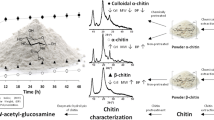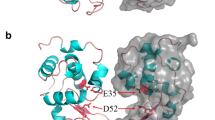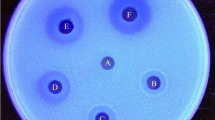Abstract
Two strains [BL21(DE3) and HMS174(DE3)] of Escherichia coli harboring the recombinant chitinase expression plasmid pVP-Chi, which contains Vibrio parahaemolyticus chitinase gene with an attached signal sequence, were prepared. These E. coli transformants produced a large amount of recombinant chitinase, which hydrolyzes chitin to yield di-N-acetylchitobiose (GlcNAc)2, under the presence of isopropyl-1-thio-β-D-galactopyranoside (IPTG), and secreted the enzyme into their culture fluid with the aid of the signal peptide. Cultivation of these E. coli transformants in Luria-Bertani medium containing squid pen β-chitin and IPTG gave rise to the decomposition of this polysaccharide and the accumulation of (GlcNAc)2 in the culture fluid. Through these experiments, we confirmed that the use of strain HMS174(DE3) was preferable for the stable accumulation of (GlcNAc)2 in the culture fluid during cultivation owing to lower (GlcNAc)2 assimilation compared to BL21(DE3). Next, using E. coli HMS174(DE3) transformants, we conducted saccharification of different forms (fluffy fiber, flake, and powder) of β-chitin samples prepared from squid pens in Bacterion-N-KS(B)K medium containing 2 % of each sample under the presence of IPTG. In these experiments, (GlcNAc)2 was isolated with a more than 20 % stoichiometric yield from each culture supernatant through charcoal column chromatography followed by recrystallization.






Similar content being viewed by others
References
Austin, P. R., Brine, C. J., Castle, J. E., & Zikakis, J. P. (1981). Chitin: new facets of research. Science, 212, 749–753.
Shahidi, F., & Synowiecki, J. (1991). Isolation and characterization of nutrients and value-added products from snow crab (Chinoecetes opilio) and shrimp (Pandalus borealis) processing discards. Journal of Agriculture and Food Chemistry, 39, 1527–1532.
Cárdenas, G., Cabrera, G., Taboada, E., & Miranda, S. P. (2004). Chitin characterization by SEM, FTIR, XRD, and 13C cross polarization/mass angle spinning NMR. Journal of Applied Polymer Science, 93, 1876–1885.
Kurita, K. (2006). Chitin and chitosan: functional biopolymers from marine crustaceans. Marine Biotechnology, 8, 203–226.
Hunt, S., & Nixon, M. (1981). A comparative study of protein composition in the chitin-protein complexes of the beak, pen, sucker disc, radula and oesophageal cuticle of cephalopods. Comparative Biochemistry Physiology, 68B, 535–546.
Tolaimate, A., Desbrières, J., Rhazi, M., Alagui, A., Vincendon, M., & Vottero, P. (2000). On the influence of deacetylation process on the physicochemical characteristics of chitosan from squid chitin. Polymer, 41, 2463–2469.
Chaussard, G., & Domard, A. (2004). New aspects of the extraction of chitin from squid pens. Biomacromolecules, 5, 559–564.
Vincentini, O., De Angelis, I., Lannuccelli, R., Silano, M., Stammati, A., & De Vincenzi, M. (2005). Protective effects of mannan in Caco-2/TC7 cells treated with wheat-derived peptides. Carbohydrate Polymers, 62, 338–343.
Suzuki, K., Mikami, T., Okawa, Y., Tokoro, A., Suzuki, S., & Suzuki, M. (1986). Antitumor effect of hexa-N-acetylchitohexaose and chitohexaose. Carbohydrate Research, 151, 403–408.
Tokoro, A., Takewaki, N., Suzuki, K., Mikami, T., Suzuki, S., & Suzuki, M. (1988). Growth-inhibitory effect of hexa-N-acetylchitohexaose and chitohexaose against Meth-A solid tumor. Chemical and Pharmaceutical Bulletin, 36, 784–790.
Tsukada, K., Matsumoto, T., Aizawa, K., Tokoro, A., Naruse, R., Suzuki, S., & Suzuki, M. (1990). Antimetastatic and growth-inhibitory effects of N-acetylchitohexaose in mice bearing Lewis lung carcinoma. Japanese Journal of Cancer Research, 81, 259–265.
Tokoro, A., Kobayashi, M., Tatewaki, N., Suzuki, K., Okawa, Y., Mikami, T., Suzuki, S., & Suzuki, M. (1989). Protective effect of N-acetyl chitohexaose on Listeria monocytogenes infection in mice. Microbiology and Immunology, 33, 357–367.
Kobayashi, M., Watanabe, T., Suzuki, S., & Suzuki, M. (1990). Effect of N-acetylchitohexaose against Candida albicans infection of tumor-bearing mice. Microbiology and Immunology, 34, 413–426.
Kadokura, K., Rokutani, A., Yamamoto, M., Ikegami, T., Sugita, H., Itoi, S., Hakamata, W., Oku, T., & Nishio, T. (2007). Purification and characterization of Vibrio parahaemolyticus extracellular chitinase and chitin oligosaccharide deacetylase involved in the production of heterodisaccharide from chitin. Applied Microbiology and Biotechnology, 75, 357–365.
Kadokura, K., Sakamoto, Y., Saito, K., Ikegami, T., Hirano, T., Hakamata, W., Oku, T., & Nishio, T. (2007). Production and secretion of a recombinant Vibrio parahaemolyticus chitinase by Escherichia coli and its purification from the culture medium. Bioscience Biotechnology and Biochemistry, 71, 2848–2851.
Wang, S.-L., Kao, T.-Y., Wang, C.-L., Yen, Y.-H., Chern, M.-K., & Chen, Y.-H. (2006). A solvent stable metalloprotease produced by Bacillus sp. TKU004 and its application in the deproteinization of squid pen for β-chitin preparation. Enzyme and Microbial Technoogyl, 39, 724–731.
Shimahara, K., & Takiguchi, Y. (1988). Preparation of crustacean chitin. Methods in Enzymology, 161, 417–423.
Keyhani, N. O., Wang, L.-X., Lee, Y. C., & Roseman, S. (2000). The chitin disaccharide, N, N’-diacetylchitobiose, is catabolized by Escherichia coli and is transported/phosphorylated by the phosphoenolpyruvate:glucose phosphotransferase system. The Journal of Biological Chemistry, 275, 33084–33090.
Marisch, K., Bayer, K., Scharl, T., Mairhofer, J., Krempl, P. M., Hummel, K., Razzazi-Fazeli, E., & Striedner, G. (2013). A comparative analysis of industrial Escherichia coli K-12 and B strains in high-glucose batch cultivations on process-, transcriptome- and proteome level. PloS One, 8, 1–16.
Rattanakit, N., Yano, S., Wakayama, M., Plikomol, A., & Tachiki, T. (2003). Saccharification of chitin using solid-state culture of Aspergillus sp. S1-13 with shellfish waste as a substrate. Journal of Bioscience and Bioengineering, 95, 391–396.
Takiguchi, Y., & Shimahara, K. (1988). N, N-Diacetylchitobiose production from chitin by Vibrio anguillarum strain E-383a. Letters in Applied Microbiology, 6, 129–131.
Acknowledgments
We thank Kenichi Koseki and Dr. Kazuhide Totani, Department of Chemical Engineering, Ichinoseki National College of Technology, for providing pens of Japanese common flying squid. This study was supported by a grant for Creative Scientific Research (C) of the Ministry of Education, Science, Sports and Culture (Japan) from 2009 to 2011. To perform this study, grant from College of Bioresearch Sciences of Nihon University was also used.
Author information
Authors and Affiliations
Corresponding author
Rights and permissions
About this article
Cite this article
Minamoto, T., Takahashi, N., Kitahara, S. et al. Saccharification of β-Chitin From Squid Pen by a Fermentation Method Using Recombinant Chitinase-Secreting Escherichia coli . Appl Biochem Biotechnol 175, 3788–3799 (2015). https://doi.org/10.1007/s12010-015-1547-9
Received:
Accepted:
Published:
Issue Date:
DOI: https://doi.org/10.1007/s12010-015-1547-9




